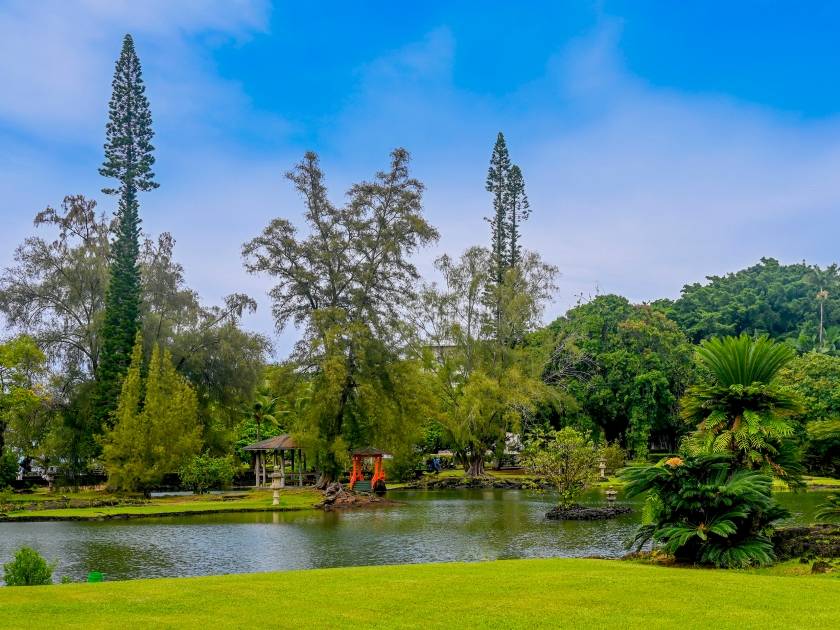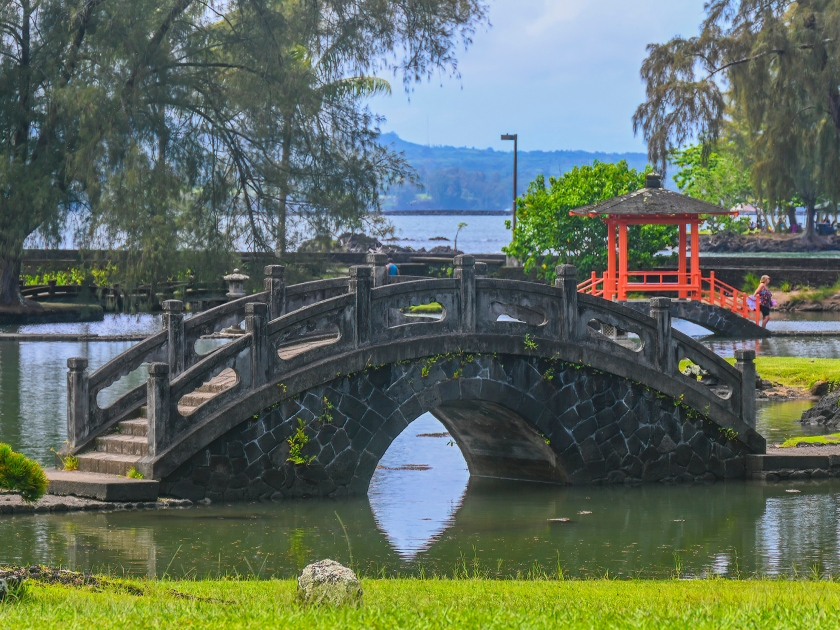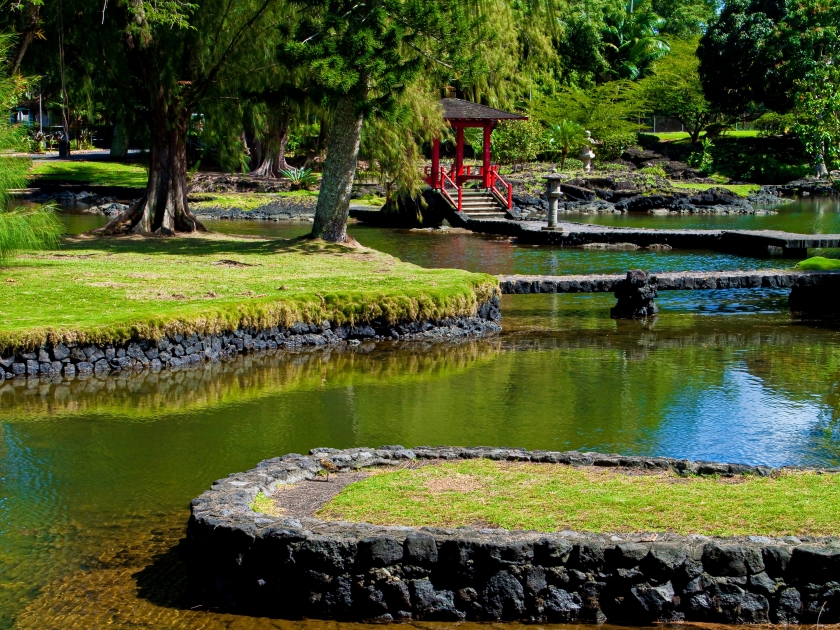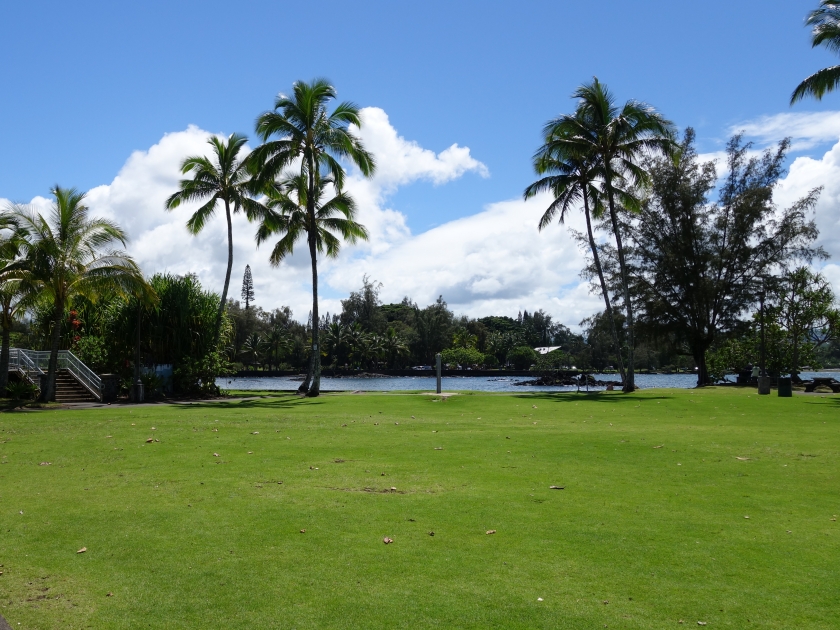In the heart of Hilo, Hawaii, Liliuokalani Gardens is a stunning 30-acre Japanese-style park that offers visitors a serene and picturesque escape. Named after Queen Liliuokalani, the last reigning monarch of Hawaii, these gardens are a testament to the cultural and historical ties between Hawaii and Japan. This travel guide will take you through the rich history, main attractions, and practical tips for visiting Liliuokalani Gardens, ensuring you make the most of your experience in this unique and tranquil haven.
Highlights
- Liliuokalani Gardens is renowned for its stunning Japanese gardens, complete with stone lanterns, pagodas, arched bridges, and koi ponds.
- The combination of lush greenery and serene water features makes it an ideal spot for photography enthusiasts.
- Learn about the historical ties between Hawaii and Japan while exploring the traditional Japanese garden elements.
- With numerous shaded areas and picnic tables, Liliuokalani Gardens is a great place for a family outing or a quiet lunch.
- The well-maintained paths throughout the gardens are ideal for jogging, walking, or even tai chi.
- Liliuokalani Gardens hosts various cultural events and activities throughout the year, such as the annual Queen Liliuokalani Festival.
History

Rich Historical Ties
The Liliuokalani Gardens boast a rich history that intertwines Hawaii’s last reigning monarch with the significant contributions of Japanese immigrants. This serene and culturally significant site tells the story of Queen Liliuokalani’s vision and the collaborative efforts that brought it to life.
Queen Liliuokalani's Generosity
The story begins with Queen Liliuokalani’s generous donation of a five-acre fishpond, Waihonu, in Hilo. In 1907, she gifted this land for the creation of a public park, laying the foundation for what would become a beloved and historically rich garden.
Period of Expansion
Between 1917 and 1919, the Hawaii Territorial Legislature expanded the grounds to 17 acres. During this period, the beautiful Japanese gardens were constructed as a tribute to the first Japanese immigrants who played a vital role in the island’s sugar industry. This expansion marked a significant period of growth and dedication to the park’s cultural heritage.
Edo-Style Design
Designed in the Edo style, Liliuokalani Gardens is celebrated as the largest authentic Japanese garden outside of Japan. Its design captures the essence of traditional Japanese aesthetics, offering a tranquil and picturesque setting for visitors.
Community Contributions
The development of the gardens was a collaborative effort, involving not just the government but also local organizations. The Hilo Japanese Women’s Friendship Association and the Hilo Board of Trade played significant roles in the park’s beautification, contributing to its charm and cultural depth.
At Present
Today, visitors to Liliuokalani Gardens can explore its stunning landscapes including the Waihonu Pond, arched bridges, koi-filled ponds, pagodas, statues, traditional torii gates, and a serene Japanese teahouse. Each feature reflects the meticulous design and cultural significance embedded in the gardens. Liliuokalani Gardens stands as a testament to the harmonious blend of Hawaiian and Japanese cultures, offering a peaceful retreat and a window into the rich history of Hilo.
Main Attractions

Japanese-Style Landscaping
The Japanese-style landscaping of Liliuokalani Gardens is a masterpiece of design, blending traditional Japanese aesthetics with Hawaii’s natural beauty. Winding paths lead visitors through meticulously maintained lawns, stone lanterns, and carefully pruned trees, creating a peaceful and harmonious environment perfect for relaxation and contemplation.
Bridges, Ponds, and Traditional Tea Houses
The gardens are adorned with elegant bridges that arch gracefully over tranquil ponds, providing picturesque spots for reflection and photography. Traditional tea houses, nestled among the lush greenery, offer a glimpse into Japanese culture and architecture, making them a highlight for visitors seeking an authentic and serene experience.
Notable Flora and Fauna
Liliuokalani Gardens boasts a diverse array of flora and fauna, featuring tropical plants and flowers that thrive in Hawaii’s climate. Visitors can enjoy the sight of blooming orchids, fragrant plumeria, and towering bamboo groves, as well as spot native birds and koi fish that inhabit the ponds, adding to the garden’s vibrant ecosystem.
Things to Do

Guided Tours and Self-Guided Exploration
Embark on a guided tour of Liliuokalani Gardens to gain insights into its rich history and cultural significance, or opt for self-guided exploration at your own pace, taking time to savor the tranquil beauty of the landscapes and hidden gems throughout the gardens.
Capture Stunning Photos
Capture the enchanting beauty of Liliuokalani Gardens by visiting its numerous photography spots, such as picturesque bridges, serene ponds, and vibrant floral displays. For the best shots, visit during the golden hours of early morning or late afternoon when the lighting enhances the garden’s natural charm.
Immerse in Cultural and Educational Programs
Immerse yourself in the cultural and educational programs offered at Liliuokalani Gardens, where you can learn about Japanese gardening techniques, Hawaiian history, and the significance of various plants and structures within the garden. These programs provide a deeper appreciation and understanding of this unique and historical site.
Amenities and Facilities

Liliuokalani Gardens is well-equipped with amenities to enhance your visit, including clean restrooms and designated picnic areas perfect for a relaxing meal amidst the beautiful surroundings. The gardens also feature accessibility paths and facilities, ensuring that all visitors can comfortably explore and enjoy the serene landscapes and cultural attractions.
Experience Events and Festivals
Liliuokalani Gardens hosts a variety of annual events and cultural festivals, celebrating the rich heritage and natural beauty of the area. From traditional Japanese festivals to local community gatherings, these events offer unique opportunities to experience the gardens in a lively and festive atmosphere. Visitors can participate by checking the gardens’ event calendar and attending these celebrations, often featuring live performances, cultural demonstrations, and family-friendly activities.
Nearby Attractions

While visiting Liliuokalani Gardens, take the opportunity to explore other points of interest in Hilo. Stroll along Banyan Drive, lined with historic banyan trees, or visit the nearby Coconut Island for stunning views and a relaxing atmosphere. To make the most of your day in Hilo, consider a suggested itinerary that includes a morning at the gardens, lunch at a local eatery, and an afternoon exploring the Pacific Tsunami Museum or the vibrant Hilo Farmers Market.
Nearby Dining Options
Treat yourself to a delicious meal at one of Hilo’s nearby dining options. Hilo Bay Cafe offers a delightful menu with a focus on fresh, local ingredients and stunning views of Hilo Bay. For a more casual dining experience, Coconut Grill provides a cozy atmosphere and a variety of flavorful dishes, making both spots perfect for refueling and reflecting on your serene garden visit.
Tips for Visiting Liliuokalani Gardens
- Bring Comfortable Footwear: Wear comfortable shoes for walking and exploring the extensive grounds.
- Pack a Picnic: Utilize the designated picnic areas for a relaxing meal amidst the scenic surroundings.
- Stay Hydrated: Carry water, especially on warm days, to stay hydrated while you explore.
- Respect the Environment: Follow garden rules, avoid disturbing wildlife, and dispose of trash properly.
- Check the Weather: Be prepared for changing weather conditions, especially if visiting during the rainy season.
- Plan for Accessibility Needs: Utilize the accessibility paths and facilities available for a comfortable visit.
- EnhAttend a Guided Tour: ance your experience with a guided tour to learn more about the garden’s history and features.
- Bring a Camera: Capture the serene beauty and unique features of the gardens.
- Explore Nearby Attractions: Plan to visit other nearby sites such as Banyan Drive and Coconut Island for a full day of exploration in Hilo.
Best Times to Visit
The best times to visit Liliuokalani Gardens are early in the morning or late in the afternoon when the weather is cooler and the lighting is perfect for photography. These times also offer a more serene experience, with fewer visitors around. While the gardens are beautiful year-round, visiting during spring and early summer ensures you’ll see the flora in full bloom, adding to the enchanting atmosphere.
Frequently Asked Questions (FAQs)
Liliuokalani Gardens is open daily from dawn to dusk, allowing visitors to enjoy the serene atmosphere at any time of the day.
No, Liliuokalani Gardens is free to enter, making it a cost-effective and beautiful destination for visitors.
Liliuokalani Gardens is located in Hilo, Hawaii, near Banyan Drive, offering easy access to one of the largest Japanese-style gardens outside of Japan.
Visitors to Liliuokalani Gardens can enjoy walking, picnicking, and exploring the scenic bridges, pagodas, and koi ponds.
Yes, Liliuokalani Gardens is child-friendly, with wide paths and plenty of open spaces for children to explore and enjoy.
Pets are allowed in Liliuokalani Gardens, but they must be kept on a leash and under control at all times.
How to Get There
By Car
To reach Liliuokalani Gardens by car, start by heading towards Hilo on the Big Island of Hawaii. If you are coming from Hilo International Airport, exit the airport onto Kanoelehua Avenue (Highway 11) heading south. Continue straight for approximately 1.5 miles, then turn left on Banyan Drive. Follow Banyan Drive for about half a mile; Liliuokalani Gardens will be on your right. There is ample parking available adjacent to the gardens.
By Bus
For those opting to take public transportation, the Hele-On bus service provides a convenient route to Liliuokalani Gardens. Board the Green Line route which runs directly towards Banyan Drive. Inform the driver that you wish to stop at the gardens, and they will let you off at the closest bus stop. The gardens are just a short walk from the bus stop, making it an accessible and environmentally friendly choice for visitors.
Embrace the Serenity
Liliuokalani Gardens offers a harmonious blend of Japanese-style landscaping, picturesque bridges and ponds, and vibrant flora and fauna, creating a tranquil haven in Hilo. With its rich cultural history and variety of activities and amenities, the gardens are a must-visit destination. Whether you’re exploring on a guided tour, capturing stunning photos, or simply enjoying a peaceful stroll, Liliuokalani Gardens promises a memorable experience. Embrace the serenity and beauty of this unique attraction on your next visit to Hilo.




